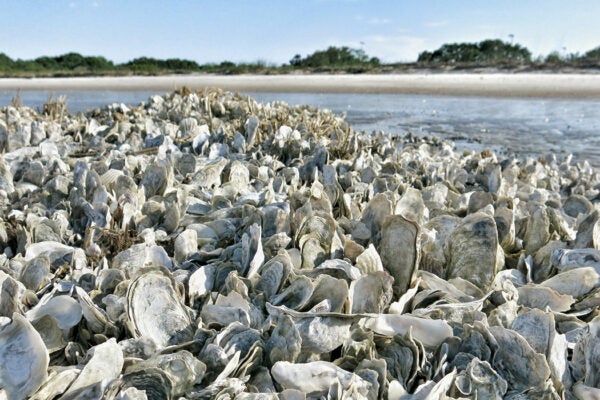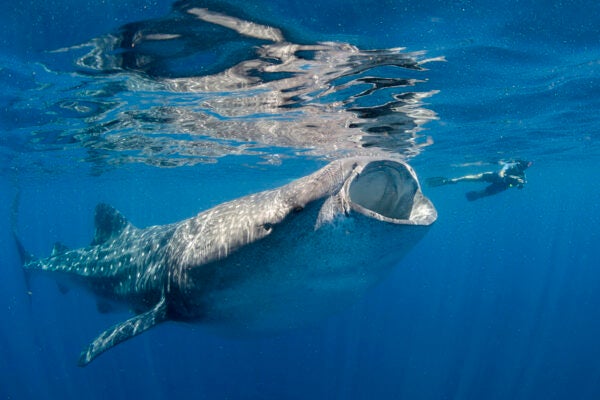Maggie Wagner has spent her last three summers living in a trailer in a remote section of central Idaho, where she collects soil samples from the ground beneath wild mustard plants (scientific name Boechera stricta). Though B. stricta is not your common backyard plant, it grows rampant in areas surrounding the Rockies. Each June, Wagner packs her bags, bids a temporary adieu to her friends in Durham, North Carolina, and leaves Bam Bam, her English Pointer mix, with a sitter. Then she joins her colleagues from the Mitchell-Olds Lab at Duke University and leaves for field season. Such is the life of a plant evolutionary geneticist like Wagner, whose research provides clues for how we can soon feed the world in a more sustainable way.
After a seven-hour flight from Raleigh-Durham to Missoula, Montana, and a two-and-a-half-hour drive from the airport, Wagner and her Mitchell-Olds’ lab mates arrive at their base camp in Salmon, Idaho: an RV campground owned by the Heald family, situated along the Salmon River. Each morning, they load up the pickup truck with supplies before driving another couple of hours to a field site like Mahogany Valley, one of the more remote locations where they collect samples and data. Their route to Mahogany Valley is treacherous, winding over the long dirt roads of Pahsimeroi Valley, and up a mountainside. “The road is pretty hairy,” recalls Wagner. “It’s kind of a stretch to call it a road at all.”
Once the team arrives at the site, a meadow that lies beneath Idaho’s tallest mountain, Borah Peak, they set out to collect soil from B. stricta‘s natural habitat. Their goal is to investigate how soil microbes in B. stricta’s environment could alter the health and fitness of these plants and make them flower more quickly. “There’s plenty of evidence about how important flowering time is for plants in the wild, and also in agricultural settings,” says Wagner. “Studying the effect of naturally occurring microbial communities on flowering time was an angle that other scientists hadn’t taken yet.”
To test her hypotheses, Wagner and her colleagues ship the samples they collect in Mahogany Valley and other Idaho sites back to Durham, where they are analyzed for microbial composition. The different populations of microbes from each site are isolated and then placed into sterilized soil, cleaned of bacteria in preparation for the necessary plant studies. By growing B. stricta with soil populated with distinct, known sets of microbes, Wagner is able to definitively tell which microbes have a direct effect on plant health.
In 2013, Wagner got the results she was looking for, and was able to confirm that soil bacteria speeds up flowering time of the B. stricta plants.
I still remember sitting there in the trailer running the model, doing the statistics, and seeing what a big effect the microbes had on flowering time,” she recalls. “I triple-checked that I had everything correct. I’ve been hurt too many times to believe something on the first try.
Her findings suggested that the shift in flowering time caused by soil microbes could increase or decrease total fruit yield by about 9 percent. Right away, Wagner knew her findings were important. She published the results in Ecology Letters in April 2014.
Wagner’s research is a great example of how basic ecology research can have a global impact. By studying these small microbes, Wagner is doing the basic science necessary to find ways of increasing agricultural production in the coming years.
Given a projected 38 percent increase in total population by 2050, one of the most important questions we have to address is how to increase food supply to feed a total of 9.6 billion people. In a 2011 article in PNAS, David Tilman estimated that food supply would have to at least double to keep up with the growing population, but that more extensive use of existing crop lands would minimize environmental concerns. Although Tilman suggested solutions such as land clearing and “more extensive” use of existing croplands to help increase yield, he and his coauthors noted that “the environmental impacts and tradeoffs… are unclear,” and called for “a trajectory that adapts and transfers technologies to underyielding nations, enhances their soil fertility, employs more efficient nutrient use worldwide, and minimizes land clearing provides a promising path to more environmentally sustainable agricultural intensification and more equitable global food supplies.”
While agriculture has significant environmental impacts, the converse is also true: environmental factors (like climate) have a significant effect on agricultural production: higher frequencies of droughts, floods, and other extreme events, attributable to climate change, are also predicted to have negative impacts on food production by 2050.
For example, the impact of increasing temperatures and drought is already evident in the Central Valley of California. Considered to be one of the most agriculturally productive locations in the world, the Central Valley is home to over 250 commodities, contributing to the state’s $53.5 billion agricultural revenue and 95 percent of US food production. Rising temperatures have caused a decrease in tule (pronounced too-lee) fog in the Central Valley, which is normally critical to protect the buds of tree nuts and stone fruits in the winter so they can bloom properly in the spring. While the loss of this thick fog might reduce the number of driving accidents, it has also led to an insufficient “rest period” for the plants, impacting crop yield.
As a result—and given the projected population changes in the coming decades—scientists have started racking their minds for potential solutions not only to maintain yield, but to boost it. Katherine S. Pope, a plant biologist at the University of California Division of Agriculture and Natural Resources, believes that selective breeding will become necessary to create crops that better withstand the more strenuous climate conditions. “People get nervous when we talk about genetic solutions, but I don’t mean GMOs: we’re not going to be taking salmon genes and inserting them into walnuts,” she clarifies. Instead, what she explains involves the breeding of walnuts, for example, that grow better in warmer climates with those that are commercially grown. However, given the long breeding cycles of some plants (a full breeding cycle for tree nuts averages about 30 years) and the time it might take to identify the genes that breeders would want to select for, these genetic solutions are unlikely to come to fruition before 2050.
Although genetic solutions may not be the most expeditious solution to problems in the Central Valley, Maggie Wagner’s work suggests that bacteria can help greatly as we move towards what National Geographic calls “The Next Green Revolution.” Tilman calls for a radical shift in thinking by the agricultural and environmental communities, and it’s plausible that bacteria can help provide many answers on how to feed the world’s growing population.
*****
It’s quite common now to hear that gut microbes are good for the human body. That’s because scientists have spent the past several decades trying to understand the role of the human microbiome—the populations of bacteria that inhabit our bodies—in health and disease. It’s time for a parallel effort in the plant world.
The work of scientists like Wagner is critical to this effort, but understanding the plant microbiome—the bacteria that associate closely with plants—presents a unique challenge. Because plants are constantly exposed to air and soil, their microbiome is much more complex than the human microbiome. The open system leads to the colonization of different populations of bacteria in the area surrounding the root, the root itself, the stem, the leaves, and the fruit. It’s difficult to pin down the role of each bacteria: in a tablespoon of soil, there are hundreds of millions—possibly even billions—of microbes. It’s mind-boggling to imagine how plants can tell friend from foe, but they seem to do so.
Moreover, in the rhizosphere, the soil directly surrounding the root, microbes are recruited based on the plant’s needs. Since plants cannot choose the soil that they grow in, they must adapt to their environment by secreting sugars and proteins that attract certain types of microbes. It’s these microbes that are essential in providing the plant added functionality. The genetics of a plant also influence what microbes are attracted to it, adding another layer of complication to genetically modified crops: in other words, perturbing the genes of a plant could potentially attract harmful bacteria to its rhizosphere.
*****
Jeff Dangl, an esteemed plant biologist, has been studying the interactions between plants and microbes for nearly three decades. On a recent trip back to his family’s home in the Central Valley, Dangl was able to see firsthand the effect of drought on the farmlands there, and lamented the changing landscape in the valley.
“What we’re dealing with now is a problem of human timelines,” he says. “Climate change is happening: it’s driven by human behavior and these changes are irreversible. If we can understand the relationship between soil chemistry, the different nutritional needs of plants, and the microbes with which a plant interacts, we can develop bacterial additives to increase crop yield, which seems to be a huge problem in the Central Valley.”
Then, he says with more conviction: “The farming industry has been predicated on plant breeding cycles, but that can take tens of years for many trees. It’s going to be done, but it’s just not going to be the best [short-term] solution for the Central Valley.”
*****
While scientists like Wagner and Dangl are digging deep to understand the connections between microbes and plants, the industries are also finding ways to scale more sustainable solutions for farming.
Monsanto, which has a long-standing reputation for genetically modifying commodity crops such as corn and soybean, is shifting towards using “biologicals,” which are products that are derived from or include live microorganisms. These tools not only have the potential to protect crops from pests and disease, but they may also improve plant productivity and fertility. Even better, these solutions can replace current fertilizers and chemical sprays used by farmers, eventually lowering the environmental impacts of agriculture. Many of these products are applied as a seed coat before plants are grown in the soil, reducing the use of water (which can be an issue in places plagued by drought).
In February 2014, Monsanto announced The BioAg Alliance with Novozymes, a global biotechnology giant dedicated to developing sustainable solutions for agriculture, bioenergy, household care, textiles, and pharmaceuticals. The Alliance brings together Novozymes’ access and capabilities for research and Monsanto’s field testing and market reach. Ultimately, the goal is to accelerate the rate of discovery of microbes that can positively affect plant health and ultimately crop yield. Just last year, both groups worked together to test their products in 170,000 field plots in 70 different locations in the US. The products that worked the best were able to deliver a 14 percent increase in yield per acre.
Other companies are also working on solutions as well. For example, because traditional pesticides contain chemicals with harmful environmental impacts, Marrone Bio Innovations (MBI) is developing biological pesticides that deliver the same effect without harming the ecosystem. Currently armed with four biological tools that are used internationally in countries such as South Africa, Ecuador, Panama, and Peru, MBI has plans of doubling their products in the coming two years and expanding their international efforts.
While biologicals are certainly hot on the market, they are just a part—albeit an important part—of the larger picture. “We need all types of tools to feed the world,” says Pamela Marrone, founder and CEO of MBI. “Biologicals can provide benefits to plants that chemicals and genetically modified crops cannot. If they provide the base of plant health, we would ultimately get much higher crop yield.”
Marrone is confident that biologicals can help solve the problem of food security. Given the diverse abilities of different soil microbes, and the investments being made towards sustainable farming technologies, it’s hard to disagree.







